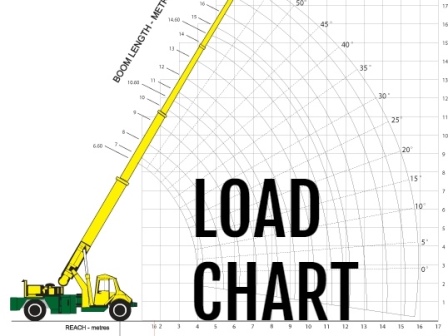The nominal loads shown in the lift chart are for each machine as originally manufactured and equipment. Modifications to the machine or the use of optional equipment other than specified may result in a reduced capacity.
Construction equipment can be hazardous if improperly operated or maintained. Operation and maintenance of this machine shall be in compliance with the information in the Operator’s and safety handbook, service manual, and parts
The operator and other personnel associated with the machine shall fully acquaint themselves with the latest American National Standards Institute (ANSI) Safety Standards for cranes.
Load Chart and sizes
SETUP:
- The machine shall be leveled on a firm supporting surface. Depending on the nature of the supporting surface, it may be necessary to have structural supports under the outrigger floats or tires to spread the load to a larger bearing surface.
- For outrigger operation, outriggers shall be properly extended with tires raised free of crane weight before operating the boom or lifting loads.
- If the machine is equipped with a front jack cylinder, the front jack cylinder shall be set in accordance with written procedure.
- When equipped with an extendable counterweight, the counterweight shall be fully extended before operation.
- Tires shall be inflated to the recommended pressure before lifting on rubber.
- With the certain boom and hoist tackle combinations, maximum capacities may not be obtainable with standard cable lengths.
- Do not travel with crane boom extension or jib erected.
Lifting operations risk assessment example
OPERATION:
- Rated loads at rated radius shall not be exceeded. Do not tip the machine to determine allowable loads. For clamshell or concrete bucket operation, the weight of bucket and load must not exceed 80% of rated lifting capacities.
- All rated loads have been tested to and meet minimum requirements, and do not exceed 85% of the tipping load on outriggers fully and 50% extended, and 75% of the tipping load on outriggers 0% extended (fully retracted) as determined by Crane Stability Test Code.
- Rated loads include the weight of hook block, slings, and auxiliary lifting devices and their weights shall be subtracted from the listed rating to obtain the net load to be lifted. When more than the minimum required hoist reeving is used, the additional rope weight shall be considered part of the load to be handled.
Load chart ratings will differ when
- Load ratings are based on freely suspended loads. No attempt shall be made to move a load horizontally on the ground in any direction.
- Rated loads do not account for wind on lifted load or boom. It is recommended when wind velocity is above 20 m.p.h (32km/h), rated loads and boom lengths shall be appropriately reduced.
- Rated loads are for lift crane service only.
- Do not operate at a radius or boom length where capacities are not listed. At these positions, the machine may overturn without any load on the hook.
- The maximum load which can be telescoped is not definable because of variations in loadings and crane maintenance, but it is safe to attempt retraction and extension within the limits of the capacity chart.
- When either boom length or radius or both are between values listed, the smallest load shown at either the next larger radius or next longer or shorter boom length shall be used.
Crane load chart safety factor
- For safe operation, the user shall make due allowances for his particular job conditions, such as soft or uneven ground, out of level conditions, high winds, side loads, pendulum action, jerking or sudden stopping of loads, hazardous conditions, the experience of personnel, two machine lifts, traveling with loads, electric wires, etc. Side pull-on boom or jib is extremely dangerous.
- If the machine is equipped with individually controlled powered boom sections, the boom sections must be extended equally at all times.
- Never handle personnel with this machine without written approval.
- Keep load-handling devices a minimum of 18 inches (45.7 cm) below the boom head at all times.
Boom angle of crane
- The boom angle before loading should be greater than the loaded boom angle to account for deflection.
- Capacities appearing above the bold line are based on structural strength and tipping should not be relied upon as a capacity limitation.
- Capacities for the 35 ft. (10.6 m.) boom length shall be lifted with the boom fully retracted. If the boom is not fully retracted, capacities shall not exceed those shown for the 40 ft. (12.2m) boom length.
- When lifting over the front of the machine, radii less than 35 ft (12m.) not recommended.
- When operating the machine in the “On Outriggers 50% Extended” mode, the outrigger beam pins must be engaged. When operating the machine in the “On Outriggers 0% Extended” mode, the outrigger beams must be fully retracted. Failure to follow these precautions could result in structural damage or loss of stability of the machine.

Mobile Crane Load Chart
Simply put, the only way to know if the load you are lifting with a mobile crane is within the limitations of the crane is to relate the lift to the manufacturer’s load chart and notes.
